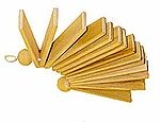
Treshchotka
Encyclopedia

Ethnic Russian music
Ethnic Russian music specifically deals with the folk music traditions of the ethnic Russian people. It does not include the various forms of art music, which in Russia often contains folk melodies and folk elements or music of aother ethnic groups living in Russia.-History:The roots of Russian...
idiophone
Idiophone
An idiophone is any musical instrument which creates sound primarily by way of the instrument's vibrating, without the use of strings or membranes. It is the first of the four main divisions in the original Hornbostel-Sachs scheme of musical instrument classification...
instrument which is used to imitate hand clapping.
Treshchotka (Clapper)
Traditional Russian idiophoneIdiophone
An idiophone is any musical instrument which creates sound primarily by way of the instrument's vibrating, without the use of strings or membranes. It is the first of the four main divisions in the original Hornbostel-Sachs scheme of musical instrument classification...
percussion instrument Treshchotka is a set of small boards on a string that get clapped together as a group
Treshchotki is commonly used in Russian folk music
Ethnic Russian music
Ethnic Russian music specifically deals with the folk music traditions of the ethnic Russian people. It does not include the various forms of art music, which in Russia often contains folk melodies and folk elements or music of aother ethnic groups living in Russia.-History:The roots of Russian...
.
Name
The word Treshchotki is onomatopoetic, since the instrument produces the sound somewhat resembling the name of the instrument itself. In Russian slang, word Treshchotka sometimes used to describe a person who is excessively chatty and loud.History
There are no known documents confirming usage of Treshchotka in the ancient Russia; however in 1992, during archeological dig in city of Novgorod, two wooden boards were found; which, by the hypothesis of Vladimir Ivanovich Povetkin, were parts of the ancient Novgorod's treshchotka of the 12th century.First published mentioning of Treshchotka is made by Kliment Vasilievich Kvitka. Great Russian lexicographer Vladimir Dahl describes treshchotka in his "Explanatory Dictionary of the Live Great Russian language" as a device made to produce crackling, thundering and racketing sounds.
At the present time some villages in Russia are still playing and crafting treshchotkas.
Construction
Treshchotka is made of a set of 15 to 20 thin oak planks/boards which are about 16 to 18 centimeters (approximately 6-8 inches) long; planks are tightly held by a rope that is threaded through the hole on top of each board. To make sure that boards are not pressed against each other a small short piece of wood (2 cm [approximately 1.5 inches]) is inserted between each board.Play
To play treshchotka one would hold it by the ends with both hands, generally at the chest or head high and alternate the motion between brusque and smooth to produce crackling and clicking sounds. This technique not only attracts listener by its sounds but also adds visual spectacle effect.Superstitions
It is noted that treshchotkas was used during peasant wedding ceremonies where instrument(s) could have been decorated with ribbons, flowers and sometimes jingle bells. The use of the treshchotka in the wedding ceremonies allows to theorize that in the past it were performing not only a role of musical instrument but also served some mystical function, perhaps protecting newlyweds from evil spirits.External links
- http://folkinst.narod.ru/index/tres/tres.html (Russian)

